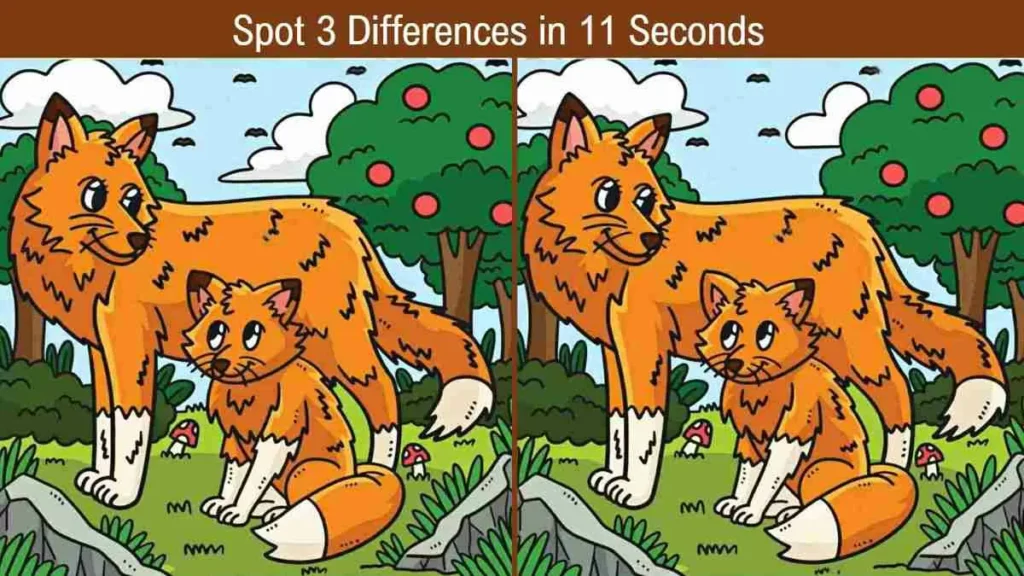In the realm of visual perception, our minds often play tricks on us, leading us to question what is real and what is illusory.
Optical illusions serve as captivating examples of this phenomenon, challenging our senses and cognitive processes.
Among the various forms of optical illusions, spot the difference puzzles stand out as intriguing tests of observation and attention to detail.
In this article, we delve into the mesmerizing world of spot the difference puzzles, focusing on a specific challenge involving lion pictures that promises to baffle even the most discerning observers.
The Allure of Spot the Difference Puzzles:

Spot the difference puzzles have captivated individuals of all ages for decades, offering a unique blend of entertainment and mental stimulation.
The premise is simple: participants are presented with two seemingly identical images, with subtle variations hidden within them.
The task is to identify these discrepancies within a limited timeframe, adding an element of urgency and excitement to the puzzle-solving process.
What makes spot the difference puzzles particularly intriguing is their ability to deceive the human visual system.
Despite knowing that differences exist between the two images, our brains often struggle to detect them immediately.
This phenomenon highlights the intricate nature of visual perception and the brain’s propensity to fill in missing information based on prior expectations and assumptions.
The Lion Picture Puzzle:
Among the myriad variations of spot the difference puzzles, the lion picture puzzle stands out as a formidable challenge.
Featuring majestic depictions of lions in their natural habitat, these puzzles lure participants into a world of mesmerizing imagery and hidden intricacies.
Despite the apparent similarity between the two images, subtle variations await discovery by those keen enough to unravel the mystery.
The lion picture puzzle presented here poses a daunting challenge: can you spot three differences between the two images in a mere 10 seconds?
According to the claim, only 3% of participants will successfully identify all three discrepancies within the allotted timeframe.
This assertion sets the stage for an exhilarating mental exercise, inviting participants to put their powers of observation to the test.
The Psychology Behind Spot the Difference Puzzles:
To understand why spot the difference puzzles can be so challenging, it is essential to delve into the psychology of visual perception.
Our brains are adept at processing visual information rapidly, allowing us to navigate the world with ease.
However, this efficiency can also lead to perceptual errors, as our brains prioritize certain features while overlooking others.
When confronted with two nearly identical images, our brains engage in a process of comparison, seeking out differences between the two stimuli.
However, this process is not always straightforward, as our attention may be drawn to salient features while overlooking more subtle cues.
Additionally, our brains may rely on familiar patterns and expectations, leading us to overlook deviations from the norm.
In the context of spot the difference puzzles, these cognitive tendencies come into play, making it challenging to identify the hidden variations.
Participants may fixate on prominent elements of the images while failing to notice minor details that deviate from the expected pattern.
Additionally, the time constraint adds an extra layer of pressure, forcing participants to rely on rapid decision-making and intuition.
Strategies for Success:
Despite the inherent difficulty of spot the difference puzzles, several strategies can improve one’s chances of success.
First and foremost, a systematic approach is crucial, as randomly scanning the images is unlikely to yield meaningful results within the limited timeframe.
Instead, participants should focus their attention on specific areas of the images, such as edges, patterns, and areas of high contrast.
Moreover, honing one’s observational skills through practice and repetition can enhance performance in spot the difference puzzles.
By training the brain to pay attention to subtle details and deviations from the norm, individuals can become more adept at detecting hidden discrepancies.
Additionally, maintaining a relaxed and focused mindset can prevent cognitive overload and enhance overall performance.
Conclusion:
Spot the difference puzzles offer a captivating glimpse into the complexities of visual perception, challenging participants to unravel hidden mysteries through keen observation and attention to detail.
The lion picture puzzle discussed in this article exemplifies the allure of these puzzles, enticing participants with the promise of a formidable challenge.
As individuals engage with these puzzles, they gain insights into the intricacies of the human mind and its propensity for both accuracy and error.
By honing their observational skills and adopting strategic approaches, participants can enhance their performance and experience the satisfaction of unraveling optical illusions.
So, can you spot the three differences between the lion pictures in 10 seconds?
With patience, perseverance, and a keen eye for detail, you just might uncover the hidden secrets lurking within the images.
